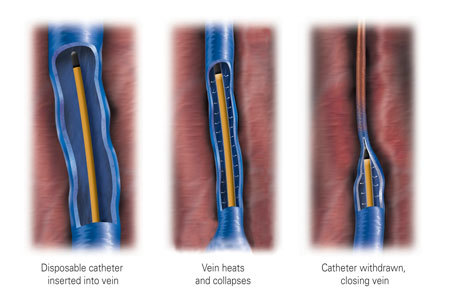Radiofrequency Ablation
During radiofrequency ablation, a thin catheter is gently inserted into the vein through the skin. The catheter emits radio waves, which heat specific areas of the affected vein, causing it to close. The catheter is withdrawn, and the healing begins almost immediately, as the closed vein is reabsorbed into the body and blood supply in that area is naturally rerouted through other, healthier nearby veins.
When is radiofrequency ablation used?
Radiofrequency ablation is an innovative, safe, office-based alternative to the outdated vein stripping operation performed in the past. Radiofrequency ablation is used to treat the great saphenous vein, the small saphenous vein, and some perforator veins (connecting veins) that transport blood from the superficial veins under the skin to the deep veins under the muscles.
What should I expect from radiofrequency ablation?
As a catheter procedure, there are four principal steps of radiofrequency ablation:
1. Mapping the saphenous vein
A typical procedure begins with noninvasive ultrasound imaging of the varicose vein to trace its location. This allows our physician to determine the site where the ablation catheter will be inserted and to mark the desired position of the catheter tip to begin treatment.
2. Inserting the closure catheter
Our board-certified physician then injects a volume of diluted anesthetic fluid into the area surrounding the vein. This numbs the leg, helps squeeze blood out of the vein, and provides a fluid layer outside the vein to protect surrounding tissue. Then, our vein doctor accesses the saphenous or another appropriate vein, inserts the closure catheter, and advances to the uppermost segment of the vein.
3. Delivery of radiofrequency energy
Noninvasive ultrasound is used to confirm the catheter tip position. The physician activates the radiofrequency ablation (RF) generator, causing the electrodes at the tip of the catheter to heat the vein wall to a target temperature. As the vein wall is heated, the vein shrinks, and the catheter is gradually withdrawn. During catheter pullback, which typically occurs over 1 to 2 minutes, the RF generator adjusts the power level to maintain the target temperature to effectively shrink collagen in the vein wall and close the vein over an extended length.
4. Follow up with ultrasound study
Ultrasound imaging is used 24–72 hours after your treatment to check for deep vein thrombosis (DVT).
What are the results of using radiofrequency ablation?
When performed by an experienced, board-certified doctor such as those at Center for Vein Restoration, the results of radiofrequency ablation are highly satisfactory, working well in about 97 percent of patients. Ablation vein closure treatment is noninvasive and far less painful than the vein surgeries of the past, such as vein stripping or ligation. After five years or more, results from newer ablation techniques are as good as more invasive older surgical techniques.
What should I do after my radiofrequency ablation treatment to ensure vein health?
Because vein disease is a progressive condition, even after treating your varicose veins with radiofrequency ablation, you're still at risk of developing new varicose veins in the future. To reduce the risk of new varicose veins in your legs, maintain a healthy weight and be sure to exercise regularly. Try not to spend extended periods sitting in one position or standing still, as this can cause blood to pool in the veins in your legs. If you notice any symptoms of new varicose veins, contact your Center for Vein Restoration physician to discuss your treatment options.
